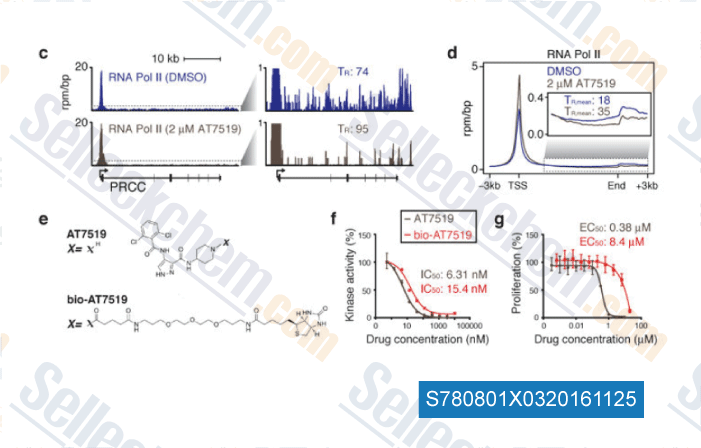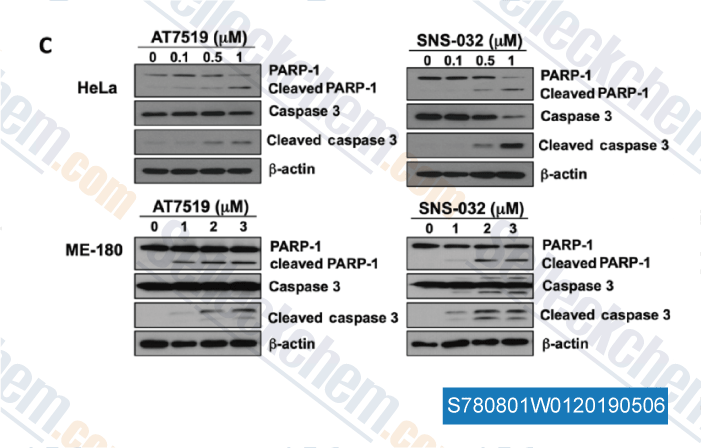|
Toll Free: (877) 796-6397 -- USA and Canada only -- |
Fax: +1-832-582-8590 Orders: +1-832-582-8158 |
Tech Support: +1-832-582-8158 Ext:3 Please provide your Order Number in the email. |
Technical Data
| Formula | C16H18Cl3N5O2 |
||||||||||
| Molecular Weight | 418.71 | CAS No. | 902135-91-5 | ||||||||
| Solubility (25°C)* | In vitro | DMSO | 52 mg/mL (124.19 mM) | ||||||||
| Water | 43 mg/mL (102.69 mM) | ||||||||||
| Ethanol | 28 mg/mL (66.87 mM) | ||||||||||
| In vivo (Add solvents to the product individually and in order) |
|
||||||||||
|
* <1 mg/ml means slightly soluble or insoluble. * Please note that Selleck tests the solubility of all compounds in-house, and the actual solubility may differ slightly from published values. This is normal and is due to slight batch-to-batch variations. * Room temperature shipping (Stability testing shows this product can be shipped without any cooling measures.) |
|||||||||||
Preparing Stock Solutions
Biological Activity
| Description | AT7519 HCl is a multi-CDK inhibitor for CDK1, 2, 4, 6 and 9 with IC50 of 10-210 nM in cell-free assays. It is less potent to CDK3 and little active to CDK7. Phase 2. | |||||||||||
|---|---|---|---|---|---|---|---|---|---|---|---|---|
| Targets |
|
|||||||||||
| In vitro | AT7519 is an ATP competitive CDK inhibitor with a Ki value of 38 nM for CDK1. AT7519 is inactive against all non-CDK kinases with the exception of GSK3β (IC50 = 89 nM). AT7519 shows potent antiproliferative activity in a variety of human tumor cell lines with IC50 values ranging from 40 nM for MCF-7 to 940 nM for SW620 consistent with the inhibition of CDK1 and CDK2. [1] AT7519 induces dose-dependent cytotoxicity in multiple myeloma (MM) cell lines with IC50 values ranging from 0.5 to 2 μM at 48 hours, with the most sensitive cell lines being MM.1S (0.5 μM) and U266 (0.5 μM) and the most resistant MM.1R (>2 μM). It does not induce cytotoxicity in peripheral blood mononuclear cells (PBMNC). AT7519 partially overcomes the proliferative advantage conferred by IL6 and IGF-1 as well as the protective effect of bone marrow stromal cells (BMSCs). AT7519 induces rapid dephosphorylation of RNA pol II CTD at serine 2 and serine 5 sites, and leads to the inhibition of transcription, partially contributing to AT7519 induced cytotoxicity of MM cells. AT7519 induces activation of GSK-3β by down-regulating GSK-3β phosphorylation, which also contributes to AT7519 induced apoptosis independent of the inhibition of transcription. [2] | |||||||||||
| In vivo | A twice daily dosing of AT7519 (9.1 mg/kg) causes tumor regression of both early-stage and advanced-stage s.c. tumors in the HCT116 and HT29 colon cancer xenograft models. [1] AT7519 treatment (15 mg/kg) inhibits tumor growth and prolongs the median overall survival of mice in the human MM xenograft mouse model in association with increased caspase 3 activation. [2] |
Protocol (from reference)
| Kinase Assay:[1] |
|
|---|---|
| Cell Assay:[2] |
|
| Animal Study:[2] |
|
References
|
Customer Product Validation

-
Data from [ , , Nat Biotechnol, 2014, 32(1): 92-96. ]

-
Data from [ , , Int J Oncol, 2018, 53(2):703-712 ]
Selleck's AT7519 HCl Has Been Cited by 12 Publications
| Interleukin-15 enhanced the survival of human γδT cells by regulating the expression of Mcl-1 in neuroblastoma [ Cell Death Discov, 2022, 8(1):139] | PubMed: 35351861 |
| O-GlcNAc transferase maintains metabolic homeostasis in response to CDK9 inhibition [ Glycobiology, 2022, cwac038] | PubMed: 35708495 |
| Cdk2 suppresses IL-23 expression and the onset of severe acute pancreatitis [ Immun Inflamm Dis, 2022, 10(6):e631] | PubMed: 35634959 |
| High-content image-based analysis and proteomic profiling identifies Tau phosphorylation inhibitors in a human iPSC-derived glutamatergic neuronal model of tauopathy [ Sci Rep, 2021, 11(1):17029] | PubMed: 34426604 |
| The cyclin-dependent kinase inhibitor AT7519 augments cisplatin's efficacy in ovarian cancer via multiple oncogenic signaling pathways [ Fundam Clin Pharmacol, 2021, 10.1111/fcp.12709] | PubMed: 34212421 |
| Development of a miRNA-controlled dual-sensing system and its application for targeting miR-21 signaling in tumorigenesis [ Exp Mol Med, 2020, 10.1038/s12276-020-00537-z] | PubMed: 33311703 |
| Inhibition of Cyclin-dependent Kinase (CDK) Decreased Survival of NB4 Leukemic Cells: Proposing a p53-Independent Sensitivity of Leukemic Cells to Multi-CDKs Inhibitor AT7519 [ Iran J Pharm Res, 2020, 19(3):144-155] | PubMed: 33680018 |
| Fibroblast growth factor receptor influences primary cilium length through an interaction with intestinal cell kinase [ Proc Natl Acad Sci U S A, 2019, 116(10):4316-4325] | PubMed: 30782830 |
| CDK Blockade Using AT7519 Suppresses Acute Myeloid Leukemia Cell Survival through the Inhibition of Autophagy and Intensifies the Anti-leukemic Effect of Arsenic Trioxide [ Iran J Pharm Res, 2019, 18(Suppl1):119-131] | PubMed: 32802093 |
| Frequent Genetic Aberrations in the CDK4 Pathway in Acral Melanoma Indicate the Potential for CDK4/6 Inhibitors in Targeted Therapy [Kong Y Clin Cancer Res, 2018, 23(22):6946-6957] | PubMed: 28830923 |
RETURN POLICY
Selleck Chemical’s Unconditional Return Policy ensures a smooth online shopping experience for our customers. If you are in any way unsatisfied with your purchase, you may return any item(s) within 7 days of receiving it. In the event of product quality issues, either protocol related or product related problems, you may return any item(s) within 365 days from the original purchase date. Please follow the instructions below when returning products.
SHIPPING AND STORAGE
Selleck products are transported at room temperature. If you receive the product at room temperature, please rest assured, the Selleck Quality Inspection Department has conducted experiments to verify that the normal temperature placement of one month will not affect the biological activity of powder products. After collecting, please store the product according to the requirements described in the datasheet. Most Selleck products are stable under the recommended conditions.
NOT FOR HUMAN, VETERINARY DIAGNOSTIC OR THERAPEUTIC USE.
